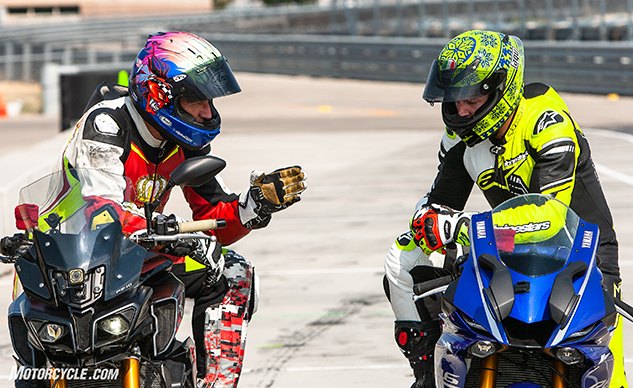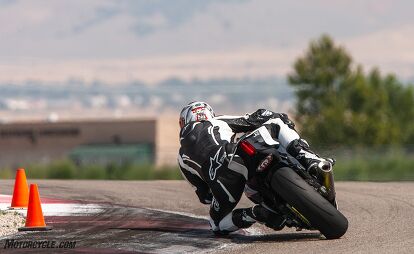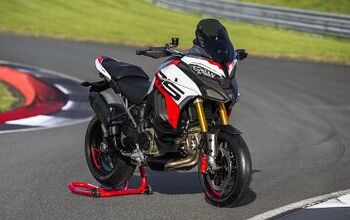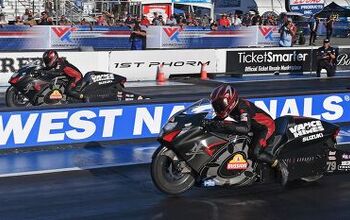The Best Investment You Can Make For Your Motorcycle Is The RiCKdiculous Racing School

Silly name, serious school
Photos by: Evans Brasfield Video by: Sean Matic and Nik Wogen
As you stare at your motorcycle at least once a day, as we’re sure most of you do, think about the best thing you ever did to it. If you haven’t done much, then take a second to think about the modifications you’d like to make to it. Now, add up what all those things would cost. You’re likely looking at a grand or two (exponentially more if you own something exotic) to get things where you want them to be.
What if I told you about a way to spend that money only once, while still positively impacting every motorcycle you ride or own after. The answer, of course, is a riding school. An often overlooked aspect of riding is investing in yourself rather than your motorcycle (yes, we’re guilty of it, too), and there’s no better way to do it than by improving your skills. Frankly, we don’t care what riding school you attend, but we’ve found schools to be the one area where you get your money’s worth every single time you ride. If you want some of the best teaching and training money can buy, look no further than the RiCKdiculous Racing School (yes, that’s how they spell it).
Pricing starts at $1500/day for two-on-one training, then bumps up to $2000/day for one-on-one coaching. Higher tiers are also available depending on the level of training you’re looking for (say, if you’re serious about winning a championship). It’s not cheap, nor is it meant to be – profit isn’t the motive, the RiCKdiculous team simply want to create the absolute best motorcycle school there is. The price will weed out the pretenders from the serious.
Personally, I’ve felt like I’d hit a plateau in my riding. I could get to a certain pace (granted, it’s a pace plenty quick enough to properly evaluate a motorcycle), but I knew there was more. The issue was accessing it without going over – a.k.a. crashing – because unlike Marc Marquez, it’s extremely frowned upon in my line of work to find new limits by exceeding the previous one then backing off a little. I needed a fresh pair of eyes to tell me where my limits were and how to raise them.
On the other end of the spectrum, we have our very own Ryan Adams. As someone with very little time on a racetrack, he needed to establish a baseline of proper fundamentals which would not only help him ride a motorcycle proficiently on the track, but allow him to ride safer on the street – a key component to our job. This is one of the beauties of the RiCK school: no matter where you are in your riding career (another student in our class had only been riding motorcycles for a month!), Ken, Adam, and the rest of the RiCK coaches can make you a better, more proficient rider. Like any sport, it all comes back to mastering the fundamentals.
Who’s RiCK?
Well RiCK is actually Josh, who’s actually a RiCK. Wait, what? It’s a silly name, no doubt, but it all stems back to Josh Bronfman’s college days, when he and his buddies would call each other “RiCK.” The whole RiCK thing stuck. Now everyone’s a RiCK. Fast forward a few years and Adam Bronfman, Josh’s father, got a motorcycle with the encouragement of his wife so they could go touring together. He did, realized there was so much to learn about the sport, and then decided to soak up everything there was to know about it.
From this desire to learn, he co-founded RiCKdiculous Racing with his son, Josh, who also entered the world of motorcycling in his adult years. They assembled a team of top level coaches and staff, including the likes of Shane Turpin and Scott “Mr. Daytona” Russell, and placed Ken Hill as the ringleader and head instructor. From there, they developed a different curriculum than any school I’ve seen elsewhere.
What’s RiCK?
Like any riding school worth its salt, the RiCK school promises lots of track time. You also get video laps, lead/follow sessions, and a detailed game plan each morning centered around your specific goals each time you ride. The separating factor is three-fold: First there’s the extremely small group sizes. At most, each coach will only have two students, and often you’ll have your coach all to yourself. RiCK schools are capped at a maximum of 10 students anyway, so traffic jams are non-existent.
Second is Adam’s extensive use of cars – including his race-prepped, and radio-equipped BMW M3 – as training devices for motorcycle riding. Here, throttle and brake inputs translate over to two wheels, while there’s a correlation between steering wheel inputs and lean angle. Having someone sitting right next to you providing instant feedback is also invaluable. For his part, Adam is an excellent driver/coach and was able to dissect my limitations on a motorcycle after only driving with me for a few minutes.
Third, and maybe most importantly, is data acquisition. Until now, rider coaching has largely been based on feel. An instructor will watch you and suggest different techniques based on what they saw and how you felt on the motorcycle, but to really understand how to improve, you need to see exactly what you’re doing and compare it to those who are doing it better. This is where data acquisition comes in. The RiCK bikes are equipped with a full electronics suite from AiM Sports to track over 50 parameters, but for our purposes we only focused on throttle position, brake lever pressure, gear position, engine speed, wheel speeds, and GPS speed. To simplify it further, we mostly looked at throttle and brakes.
Let’s RiCK!
Each morning starts with a rider’s meeting in which Ken gets everyone in the right mindset. First and foremost, this is a school. Meaning everyone needs to allow themselves to let their guards down, leave the egos at home, and open their minds for learning. From there each student gets a folder – this is a school after all – containing several sheets of paper, including a report card, graphs, and drawings, the latter two displaying different arcs and the proper lines through them, and what braking pressure looks like on a chart. There are also blank pieces of paper to take notes on, something that is highly encouraged.
By far the most important piece of paper in the folder is the very first page, entitled: 5 Reasons We Crash. Curious? Here they are:
- Lack or loss of focus
- Abrupt inputs
- Rushing DIRECTION
- Repeating mistakes
- Overconfidence
Since the whole goal here is to avoid falling down on a motorcycle, Hill spends a lot of time talking about the first page. For the most part, these should be simple to understand. Much time is spent discussing all five, and the beautiful thing about Ken Hill’s teaching method is his ability to explain these concepts in normal language everyone can understand. For those who never really liked the classroom portion of school fear not; this is the most you’ll spend in a chair looking up at teacher and whiteboard. From here it’s off to the track.
Right off the bat, the difference between the RiCK school and others is upon you. After the rider’s meeting, students head off with their instructor for laps in a car. It starts off with the coach driving, followed by the student. Because Ryan and I had two vastly different goals to work on, we split up and worked with Ken (Ryan) and Adam (me). And because there were so few other students in our particular school, we each got our instructors entirely to ourselves for the whole day.
In Ryan’s case, because he was so green to track riding, he was basically a blank canvas for Hill. “When Ken asked what I was looking to gain from the experience, I stumbled a bit,” says Ryan. “I wasn’t really sure what to tell him, but what I wanted to say was: ‘EVERYTHING, teach me everything.’” This worked out great for Ryan, as Hill didn’t have to fix any bad habits our boy Ryan might have learned over the years.
Things worked out a little differently for me. After Adam handed over the wheel, I had hardly gone seven corners before he was able to pinpoint my weakness – and I hadn’t even said what my goals were yet. I was on the throttle, but still trying to find direction. In other words, I wasn’t maximizing brake application to slow the vehicle and have it point in the direction I wanted before getting back on the gas. Having already broken me down within 30 minutes of meeting me, Adam’s enthusiasm and reassurance was comforting. “You didn’t even have to tell me your goals, and I know what we need to work on,” he said. “Once you see the data, you’ll see exactly what I’m talking about, and we can fix it.”
As it turns out, Ryan was having a similar, though more basic, conversation with Ken during his car ride. “Discussing braking and the effect it can have on tightening or widening turns is much more apparent in a car,” Ryan said. “So, it was easy way to see the application working in real time as the coach explained it.”
After the car ride, it’s time to don the leathers and go ride. Unlike a trackday though, here you’re riding with purpose. In Ryan’s case, Ken started things off easy with him, pointing out lines and focusing on the bare essentials. There was a lot of lead/follow and video work as well. This way Ryan could also see the actions he was making on the motorcycle from a different perspective. “Heading back into the garage with video to discuss between sessions was incredibly helpful. I could see most of the points I may have missed or issues I was having and could remember the feeling on the track. With Ken’s guidance throughout the two days, I was making improvements in every session, which made the entire process even more enjoyable.”
Having already taken schools in the past, including others taught by Ken, Hill and Bronfman decided to throw me to the wolves immediately, putting me on the RiCK school Yamaha YZF-R6 equipped with full data acquisition equipment – little did I know this would end up being my home for the next day and a half. Our sessions would begin with lead/follow between Adam and myself, and the more we rode, the more I was given freedom to lap. After each session, however, Adam wanted to see the data – and this is where the breakthrough happened.
With my riding data displayed on Adam’s giant display inside the RiCK big rig, the data traces of my best laps were overlayed with Ken’s baseline laps he had set earlier in the day. The verdict? Ken was braking later, releasing it smoother, and getting on the gas earlier and smoother. Where his data traces looked like squares with the bottoms lobbed off, mine looked like I had an asthmatic fit while trying to draw a straight line. Not pretty.
But the message was clear: I had to work on smoothing those lines. Not only that, but the data also gave me concrete and specific areas to improve. With Adam’s expert interpretation of the data – reinforced with video – I knew what I had to do on the motorcycle to make those changes. Never had I attended a school before where the setback in my riding – and the appropriate remedy – were so clearly defined.
“This is the difference,” says Adam. “All this equipment is expensive, but we’re not afraid to spend the money for the absolute best equipment and best solutions out there. All because we want to make riding a motorcycle as safe as we possibly can.” With this knowledge Adam and I both worked out a game plan for the rest of the school: brake more efficiently and reapply throttle quickly and smoothly.
To reinforce the message yet again of how effective cars can be in developing skills on a motorcycle, Adam took both Ryan and I out in his race-prepped BMW M3. As Ryan explains, “We had comms set up so Adam could walk us through his thought process, braking, accelerating, etc. as we turned some of the fastest laps he had put down over the weekend. More than just being a fun experience, it was another chance to see the similarities between making our way around the track on four wheels or two, at an accelerated pace from the rental cars used the day before.”
With repetition of the directions Adam gave me, lap after lap, I eventually was riding at a pace Adam was having a hard time following for video. As a testament to Adam’s skill analyzing and interpreting video and data, despite my lap time being slightly faster than his, he was still able to accurately pinpoint details in my riding that still needed work.
At the end of the day, the data didn’t lie: I had gone 2.2 seconds faster than I had at the start of the school, even eclipsing Ken Hill’s baseline laps he had set for reference. Better still, the pace came easily to me, and I never felt like I was pushing my limits. Maybe best of all, though, is the fact that the skills and lessons I was taught at the school are things I’ll constantly be working on each time I ride – street or track. As Ken Hill likes to say, “Everything we teach definitely carries over to the street – only the degree of application changes.”
As for Ryan, he managed to drop over 12 seconds from his lap time by the end of the school. “The fact that I was able to spend two days of personalized one-on-one training with a coach the likes of Ken Hill made me the most attentive and focused student I have ever been in my life. I absolutely trust and believe in Ken’s experience as a coach and wanted to soak up anything I could from our time together like a giant race leather-shod sponge. With Ken’s guidance throughout the two days, I was making improvements in every session, which made the entire process even more enjoyable.”
Slick, RiCK
To say we’re believers in the RiCK system is an understatement. The techniques work, the instruction style is first rate, and in my case, data acquisition is a game changer. Also, the experience is just flat-out fun. Take it from Ryan, “The fact that the folks at RiCKdiculous Racing are willing to put together these types of schools where they rent the track, provide food, rental bikes if you need them, one-on-one coaching, and an environment in which everyone is stoked to be at and respects each other, is unlike any other track school program out there. Do yourself a favor and jump on the RiCK train.
“The name’s RiCKdiculous. The coaching, atmosphere, and overall quality of the personalized coaching during the RiCK days are absolutely invaluable.”

Troy's been riding motorcycles and writing about them since 2006, getting his start at Rider Magazine. From there, he moved to Sport Rider Magazine before finally landing at Motorcycle.com in 2011. A lifelong gearhead who didn't fully immerse himself in motorcycles until his teenage years, Troy's interests have always been in technology, performance, and going fast. Naturally, racing was the perfect avenue to combine all three. Troy has been racing nearly as long as he's been riding and has competed at the AMA national level. He's also won multiple club races throughout the country, culminating in a Utah Sport Bike Association championship in 2011. He has been invited as a guest instructor for the Yamaha Champions Riding School, and when he's not out riding, he's either wrenching on bikes or watching MotoGP.
More by Troy Siahaan









































































Comments
Join the conversation